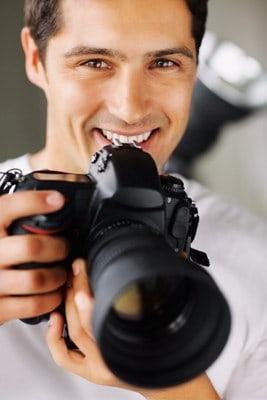
Zooming in on a subject gives the photographer a lot of options. A telephoto lens compresses the background, but it can also isolate the subject and make them “pop”.
Sometimes you will hear photographers say “zoom in to 100%”. What they mean is to zoom in to the maximum focal length your lens will allow. Take one of the most popular lenses: the Nikkor 70-200mm lens. Instead of your subject looking lost at 50mm (which is basically what the human eye sees), zoom in to 200mm and you will see your subject fill the frame. Having that ability is wonderful in situations where you don’t want to intrude (like at a wedding, when you want to capture an intimate moment between the bride and groom, or out in the wild where you don’t want to spook the wildlife (or worse, get too close and become a grizzly bear's lunch)).
At a short focal length (such as 50mm), the background looks distant and small. But zoom in to 200mm and the background gets compressed. Distant objects (such as a mountain range) look much closer, thus giving you a shallower depth of field. This characteristic of telephoto lenses is great for landscape photography. It gives the scene a layered, three-dimensional feeling with a foreground, middle ground, and background.
Portrait photographers have taken advantage of the telephoto’s ability to compress. Using a telephoto lens such as 70-200mm can be flattering to your model because it compresses the features of the face and flattens the nose.
As with anything in photography, sharpness is a fundamental objective. Telephoto lenses, particularly in the range of 300mm or even 500mm, can be large and bulky. With just the slightest movement, your photograph could turn out blurry or fuzzy. This is known as camera shake. Newer telephoto lens now come with a feature known as optical stabilization (called vibration reduction (VR) on Nikon lenses and image stabilization (IS) on Canons) when hand-holding your camera is the only option.
As always, a photographer’s best friend is the tripod because it can eliminate camera shake entirely in low light situations or where a slow shutter is used. If you don’t own a tripod (or even a monopod), try bracing yourself against a tree, wall or something immovable to prevent the camera and lens from moving. Always keep one hand under the lens for support with your elbows tucked in close to your body, and hold your breath before clicking the shutter.
A nice but often overlooked feature of your DSLR camera is the zoom function. Zooming in is a function found in almost every DSLR these days. After you take your shot, look for a magnifying glass (often found on the back of the camera). With this function, you can zoom in and pan around your photo to ensure that every detail is in sharp, clear focus.

Welcome Christine. However I hope you won’t mind me intruding but I found your intro on the improve photography site extremely patronising, sexist and not at funny. I realise you didn’t write it but I just wanted to say that it does not convey the right professional image for the company.
Hi Michael,
Thank you for the welcome, and for your concern. I am sorry you feel my bio isn’t appropriate, but I assure you that I wrote it myself, and every word is accurate. I suppose that maybe (maybe?) if my bio had been written by one of the guys I could see (maybe?) how it might (maybe?) appear sexist or patronizing… But rest assured – Jim and Dustin aren’t sexist and I’m certainly not either! Thanks for looking out for me, though – I appreciate the concern. 🙂
Wonderful article!
Although I have read that zooming in does not really display everything when you shoot in raw, but only in Jpeg. You can’t actually see the real raw image on the display even if you zoom in very much, as on the LCD screen is only viewable the Jpeg version of the raw photo.
Thanks for sharing this with us.
Morpho